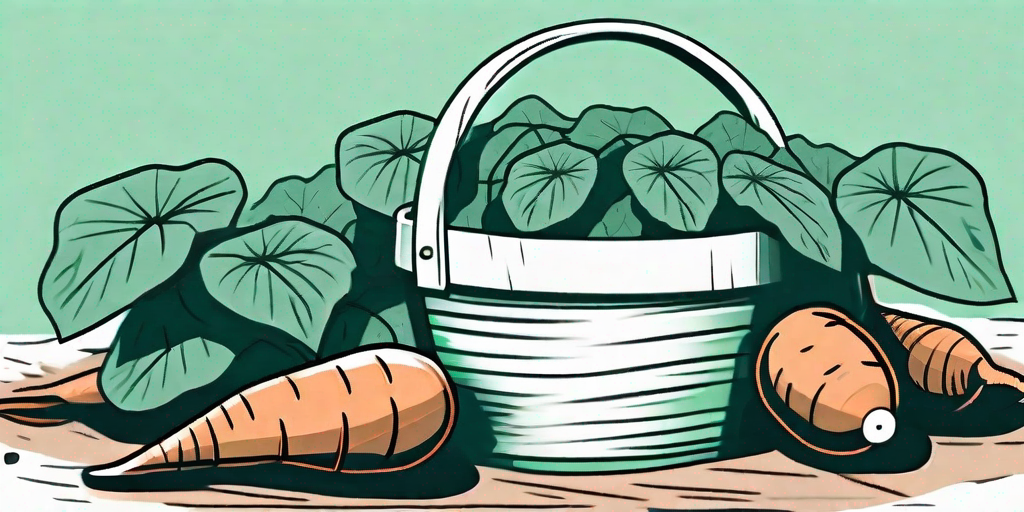
Welcome, green thumbs and potato enthusiasts! If you're reading this, you're probably looking to grow your own sweet potatoes. Or maybe you're just a fan of long, comprehensive articles about root vegetables. Either way, you're in the right place. We're about to embark on a journey into the world of sweet potato harvesting. Buckle up, it's going to be a tuber-ific ride!
Understanding Sweet Potatoes
The Life of a Sweet Potato
Before we dive into the nitty-gritty of harvesting, it's important to understand the life cycle of a sweet potato. These delightful tubers begin their lives as slips, which are sprouts grown from a mature sweet potato. Once planted, they grow into a vine-like plant. After a few months of growth, the plant begins to produce the sweet, starchy tubers we all know and love.
Harvesting usually takes place in late summer or early fall, once the leaves have started to yellow. But don't worry, we'll get into the specifics of timing your harvest later on. For now, just remember that patience is a virtue, especially when it comes to growing sweet potatoes.
Choosing the Right Variety
Did you know there are over 400 varieties of sweet potatoes? That's a lot of tubers! While most people are familiar with the orange-fleshed variety, sweet potatoes can also be white, yellow, pink, and even purple. Each variety has its own unique taste and texture, so it's worth experimenting to find your favorite.
When choosing a variety to grow, consider your climate and soil conditions. Some varieties are more drought-resistant, while others prefer a more humid environment. Do your research and choose a variety that's well-suited to your garden.
Planting and Growing Sweet Potatoes
Starting from Slips
As mentioned earlier, sweet potatoes are grown from slips, not seeds. You can buy slips from a garden center or online, or you can grow your own from a store-bought sweet potato. To grow your own slips, simply cut a sweet potato in half, place it in a jar of water with the cut side down, and wait for sprouts to appear. Once the sprouts are about four inches long, they're ready to be planted.
When planting your slips, choose a sunny spot with well-drained soil. Sweet potatoes are tropical plants, so they love the sun. They also hate soggy feet, so make sure your soil drains well. Plant your slips about 12 inches apart and water them well. Then sit back, relax, and watch your sweet potatoes grow.
Watering and Fertilizing
Sweet potatoes are fairly low-maintenance plants, but they do have a few specific needs. They prefer a consistent watering schedule, so try to water them regularly. However, be careful not to overwater, as this can lead to root rot.
As for fertilizing, sweet potatoes aren't picky eaters. They'll do fine with a general-purpose garden fertilizer. Just be sure not to overdo it, as too much fertilizer can lead to lush vines but few tubers.
Harvesting Your Sweet Potatoes
Timing is Everything
So, you've planted your slips, watered and fertilized them, and now you're ready to harvest. But when is the right time? As a general rule, you should start checking for readiness around 100 days after planting. Look for yellowing leaves as a sign that your sweet potatoes are ready to be harvested.
However, don't wait too long! If left in the ground too long, sweet potatoes can become woody and less tasty. It's a delicate balance, but with a little practice, you'll become a sweet potato harvesting pro.
The Harvesting Process
Harvesting sweet potatoes is a bit like hunting for buried treasure. You'll need a spade or garden fork to gently dig around the plants, being careful not to damage the tubers. Once you've unearthed your sweet potatoes, let them dry in the sun for a few hours before storing them.
Remember, sweet potatoes are quite delicate and can bruise easily. Handle them with care to ensure they stay fresh and tasty for as long as possible.
Storing and Using Your Harvest
Curing and Storing
After harvesting, sweet potatoes need to be cured. This process involves storing them in a warm, humid environment for about 10 days. Curing helps to heal any small cuts or bruises and improves the flavor and storage life of your sweet potatoes.
Once cured, sweet potatoes can be stored in a cool, dark place for several months. Just be sure to check on them regularly and remove any that start to go bad.
Cooking with Sweet Potatoes
Now for the fun part: eating your sweet potatoes! These versatile tubers can be used in a variety of dishes, from savory to sweet. Try them roasted, mashed, baked, or even in a pie. The possibilities are endless!
And don't forget about the leaves! Sweet potato leaves are edible and can be used in salads or sautéed like spinach. Who knew sweet potatoes could be so versatile?
Frequently Asked Questions
- Can I grow sweet potatoes in containers?
Yes, sweet potatoes can be grown in large containers. Just be sure to choose a container that's deep enough to accommodate the growing tubers. - How many sweet potatoes will one plant produce?
On average, one sweet potato plant will produce between 3 and 5 pounds of potatoes. - Can I eat sweet potatoes straight from the garden?
While you can eat sweet potatoes straight from the garden, they'll taste better if you let them cure first.
And there you have it, folks! Everything you ever wanted to know about sweet potato harvesting (and probably a bit more). Now go forth and grow some tubers!











